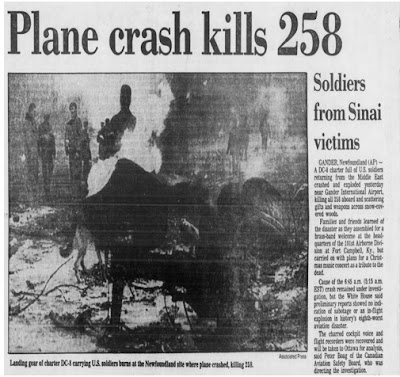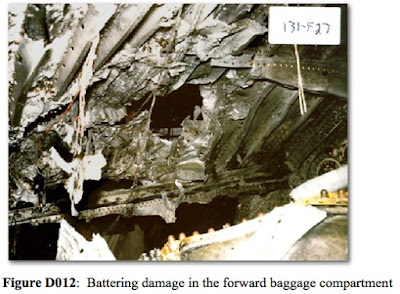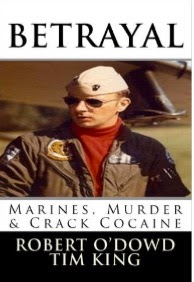Robert O’Dowd
Military chartered aircraft deliberately destroyed to prevent the public disclosure of an aborted covert operation to use a nuclear weapon in the Middle East.
(GANDER, NEWFOUNDLAND) – A US Army Special Forces mission to rescue hostages held by Hezbollah and to use nuclear backpacks to blowup an Iraqi nuclear research facility led to the deaths of hundreds of 101st Airborne troops returning from a six-month tour with the Multinational Force and Observers (MFO) in the Sinai and Special Forces personnel when their aircraft was deliberately destroyed in Gander, Newfoundland, on December 12, 1985. Arrow Air 1285 (DC-8-63CF) flight originated in Cairo, stopped in Cologne to change crews and refuel and landed at Gander to refuel but after takeoff, the aircraft loaded with 45,000 liters of jet fuel, never reached more than 1,000 feet in altitude before an incendiary device and napalm planted in soda cans on the aircraft were remotely detonated with the loss of 256 Americans. The Canadian Air Safety Board (CASB) was in charge of the investigation of the crash. Neither the Canadian or US governments conducted a criminal investigation to rule out sabotage. For both governments, the cause was icing on the wings and fuselage but that was determined to be unsupportable in the opinion of the professional experts on the CASB.
There was more than enough time for terrorists to plant a bomb on the aircraft in Cairo. The aircraft was on the ground in Cairo for five hours (17:34Z to 22:35Z). There was only one guard while a loss of electrical power kept the plane in darkness for half an hour.
The first refueling stop was at Cologne, West Germany, where the aircraft was on the ground two hours (1:21Z to 3:20Z).[i] A bomb was planted on the aircraft in Cologne, not by terrorists but by CIA operatives or cut-outs who used soda cans filled with an incendiary device and napalm and remotely detonated the soda cans on take-off from Gander, Newfoundland. The evidence of explosive material was found in dumpsters at Cologne and CIA operatives were on the ground in Gander when the aircraft landed for refueling. The motive for the destruction of the aircraft was to prevent Special Forces on the aircraft from leaking the news of an aborted covert mission to use a nuclear backpack to destroy an Iraqi nuclear weapons research facility. The aborted mission resulted in the deaths of several Special Forces. The aborted mission to use a nuclear backpack in the Middle East would have had severe political consequences for the US. The solution for those involved was to destroy the aircraft and murder all on board.
Figure 9-1: Pittsburgh Post-Gazette, December 13, 1985
FIRE AND IN FLIGHT EXPLOSION
Both the Canadian and US governments denied any terrorist activity while the fires still raged in Gander, made no attempts to investigate terrorist activity, and instead, cited with the CASB majority report opinion that the crash was caused by icing on the wings and fuselage, which increased drag and caused the DC-8-63 to stall and crash. The CASB “was unable to determine the exact sequence of events which led to this accident. The Board believes, however, that the weight of evidence supports the conclusion that, shortly after lift-off, the aircraft experienced an increase in drag and reduction in lift which resulted in a stall at low altitude from which recovery was not possible. The most probable cause of the stall was determined to be ice contamination on the leading edge and upper surface of the wing. Other possible facts such as a loss of thrust from the number four engine and inappropriate take-off reference speeds may have compounded the effects of the contamination.” [ii]
CASB MINORITY REPORT
The four professionals on the (CASB) who included two aeronautical engineers and pilots with thousands of hours in the air, reported in a CASB minority report[iii] that the aircraft was destroyed by fire and explosion while in the air, not by icing:
WITNESSES SAW FIRE
On the day after the accident, one of the witnesses who saw the aircraft pass over his truck testified, “I think the right-hand side of the aircraft was on fire.” He later explained that the “yellow/orange glow” seemed to come from the right-hand side “fairly close to the body” and it was so intense that he could see writing on the aircraft’s tail. When asked to locate the source of the glow at the Board’s public inquiry, he pointed to the cargo compartment at the juncture of the right wing and the fuselage.
The other eyewitness who saw the aircraft pass directly overhead said, “My first impression of the glow was that it was a fire.” He could only say that the glow came from the “bottom side” of the aircraft. It was bright enough to illuminate the cab of his truck. This witness also noted that he lived by an airport and this light was not like any other he ever saw on an airplane.
The eyewitness who saw the aircraft pass in front of him from right to left stated. “I couldn’t see the right-hand side of the airplane. But I could tell that it was very bright on that side of the plane, like something was on fire.”
A witness who is not mentioned by the majority observed the take-off run of the Arrow Air DC-8 from a parking lot near the Gander Airport terminal building. This witness saw the Arrow Air DC-8 taxi out, heard the take-off, and then saw a flash and what appeared to be a “large orange oval object” which then “blew up” and “went into a million pieces”. The witness located this “object” low in the sky in a direction that would have placed it on the extension of the runway somewhere close to the Trans-Canada Highway.
The possibility of a fire prior to the main explosion is reinforced by the other witness observations. The crew of an aircraft in the vicinity saw “the sky light up” a few seconds before the fireball of the main explosion. A witness on the ground reported that “there was a second burst of flame that shot up in the air as well. It would appear to me that there was a second explosion.”
Thus, a review of the testimony relating to the “orange/yellow glow” reported by eyewitnesses leads us to conclude that this glow may have been a fire burning through the lower right fuselage near the wing root.
MEDICAL FINDINGS QUESTIONED
Lethal levels of combustion products in toxicological samples show that a large number of victims continued to breath while exposed to fire. Based on the Official Registration of Death certificates, which describe death as instantaneous for all victims, we would have to conclude that there was a fire on board before the crash.
In April 1988, consultants for the Board reexamined injury patterns recorded during the autopsies. They concluded that many of the victims could have survived for up to five minutes. Analysis based on this finding led the majority to impute all evidence of inhaled combustion products to post-impact exposure. This implies that several victims must have been decapitated after surviving the crash and inhaling lethal combustion products.
A consulting pathologist who studied the available information independently advised us that the analysis of the majority does not rule out the possibility of a pre-impact fire. We understand that injury patterns do not provide definitive indication of survival time, or more specifically, of the time the victim continued to breath after injury.
The cause of death may have been clarified by correlating specific injury patterns with carbon monoxide levels. The results are all the more ambiguous since carbon monoxide levels seem uncorrelated with ground fire patterns. In any event, correlations based on location within a grid mean that the conclusions, in so far as they are valid, apply only in some average sense.
To us, the massive destruction of the aircraft suggests unsurvivable decelerative forces. A detailed analysis of these forces could have provided a cross check on the results of the injury pattern analysis.
We also note that the medical examinations found that all injuries consistent with a blast wave or shrapnel from an explosion could also have been sustained during the crash. Nevertheless, the medical report submitted in support of the majority finding indicates that “an explosion within a cargo area might then have its effects on passengers deflected and thus leave no trace on the victims.”
SIGNIFICANT CIRCUMSTANCES
A variety of indirect, circumstantial evidence gives substance to eyewitness testimony suggesting a fire on the lower right-hand side of the fuselage. Such a fire may also explain the evidence of seemingly unrelated systems failures.
The majority explains that “considerable speculation” about an in-flight detonation “was fueled by the fact that military personnel and equipment were aboard the flight and by the increasing world-wide incidence of terrorist activity. Also contributory to this speculation was the point of origin of the flight … .”
The point of origin, Cairo, was suspect in that the security arrangements for loading the soldiers and their baggage were not ideal. Previous operations of Arrow Air for the MFO in Egypt had used El-Gorah Airport in the Sinai Desert. Construction at El-Gorah necessitated a last minute switch to Cairo. Troops of the 101st Airborne arrived from the Sinai in two Egyptian Air 737s about five hours before the arrival of the Arrow Air DC-8. Baggage and other equipment were tracked in and parked in a holding area prior to loading. Only a portion of the hold baggage was inspected.
After the first 45 minutes. the ground stay at Cairo was in darkness. Baggage and cargo were loaded without military supervision. Testimony at the Board’s public inquiry revealed a chaotic process. The auxiliary power unit failed twice, leaving the aircraft in darkness with only one “semi-uniformed” guard believed to be an Egyptian soldier. It is reported that fighting broke out among the ground handlers beneath the tail of the aircraft, possibly during one of the blackouts.
The security arrangements at Cairo take on added significance in light of the bomb that exploded aboard a TWA 727 in April 1986, tearing a hole in the fuselage and killing four passengers. The bomb was reported to consist of a small amount of plastic explosive about the size of two cigarette packs of a design favoured by Palestinian terrorists. It exploded under the seat of a passenger who had boarded in Cairo and left the aircraft during a stopover in Rome.
The day after the Arrow Air disaster, a group calling itself the “Islamic Jihad” claimed responsibility. We understand that the claim was made to the media and also by means of a telephone call from Lebanon to the CASB headquarters in Hull on 13 December 1985.
The “Islamic Jihad” or “Islamic Holy War”, a secretive pro-Iranian terrorist group had previously claimed responsibility for two separate car bombings of the U.S. embassy in Beirut, murder of the president of the American University of Beirut, laying mines in the Red Sea, and the kidnapping of American, Russian, and French nationals. The organization had demonstrated great sophistication in the use of explosives and may have been responsible for the terrorist attack that killed 241 American members of the multinational peacekeeping force at Beirut Airport in October 1983. This attack was a major political setback for the U.S. administration who stood accused of failing to ensure the safety of American peacekeeping forces. Terrorist groups would certainly have been eager to repeat what, from their point of view, was a major success.
In July 1985, five months before the Arrow Air accident, the “Islamic Jihad” claimed responsibility for a bomb attack that killed 27 at Copenhagen, Denmark. Anonymous spokesmen for the organization announced that the attack was in retaliation for raids in Southern Lebanon and warned that terrorist operations would no longer be confined to the middle east.
At the time of the Arrow Air accident, the U.S. government was negotiating with the “Islamic Jihad” for the release of six American hostages.
The remaining factor leading to “considerable speculation” of in-flight detonation noted by the majority concerns “the fact that military personnel and equipment were aboard the flight.”
On 26 February 1986, an incident described as a “catastrophe waiting to happen” occurred at Norton Air Force Base near San Bernardino, California. A bag being loaded on a DC-8 military charter broke open, revealing contraband explosive material. A search of the baggage found a variety of detonator cords, machine gun ammunition, blasting caps, slap flares, and other explosive materials.
Another military charter was involved in a similar incident at Oklahoma City on 19 April 1986. A precautionary search after a bomb threat “resulted in the recovery of various items of military ordinance which were being transported without authorization as souvenirs.”
A bulletin issued by the Director of Civil Aviation Security noted that “among the items recovered was a trip flare with the triggering pin loosened. rendering it extremely dangerous.” It went on to note that “if the trip-flare had been set off a magnesium fire would have resulted.” The bulletin also stated that “the U.S. Army Explosive Ordinance Disposal Unit disclosed that the item, if triggered, would have resulted in a severe fire and probable crash of the aircraft.”
These incidents, which occurred several months after the Arrow Air DC-8 accident, suggest that clues about the cause might be found in the uninspected baggage. The majority found that “the integrity of Class D cargo compartment was compromised because flight was undertaken with two missing side panels in the number three cargo pit.” These panels provide a flame resistant lining and prevent ventilation so as to suffocate any fire that may break out. There are neither alarms nor extinguishing systems. Thus, a fire could propagate undetected in a cargo compartment missing some of these panels.
A magnesium fire resulting from accidental detonation of a “trip flare” in a forward cargo compartment could produce an intense glow with no apparent flames as it bums through the lower fuselage. The intense heat generated by such a fire could destroy control cables and other systems with unpredictable, catastrophic results. In addition to multiple system failures, the consequences could include false cockpit warnings. The crew may be disabled. If not, they may be unable to raise the landing gear, may discharge a fire bottle, and may even attempt to abort the take-off.
In short, a single hypothesis of fire or explosion in a cargo hold can explain many aspects of the accident which need diverse and at times far-fetched assumptions with the ice-contamination hypothesis. These include contradictory evidence about engines, thrust reversers, and flaps; right turn and yaw despite full opposite control; failure to raise the gear despite loss of airspeed; an intentionally discharged rim bottle; inconsistent EPR and N1 tachometer readings.
We would expect much of the evidence of in-flight detonation or fire to be obliterated by the subsequent ground fire. Moreover, we would also expect that meticulous scrutiny of the wreckage might uncover definitive residual signs.
INCOMPLETE WRECKAGE ANALYSIS
The section “Fire Investigation” in the International Civil Aviation Organization’s Manual of Accident Investigation outlines techniques for examining wreckage to determine if a post-crash ground fire could have masked evidence of an earlier in flight fire.
The most potent technique is to attempt to reconstruct the aircraft from the remaining parts in order to detect a pattern in soot deposits or other signs of fire. Patterns in the flight direction would indicate the presence of an in-flight fire, as would continuity of patterns across lines of failure. Lack of soot deposits on fracture surfaces adjacent to a burned surface would indicate that the fracture occurred after the surface had been exposed to fire.
The examination of the wreckage conducted in support of the majority findings was described as follows:
“All wreckage was recovered from the site and moved to a secure hangar at the Gander Airport, where it was arranged in a grid pattern which matched the grid pattern established at the site. A thorough examination of the wreckage was completed, and further selected components were forwarded to the CASB’s Engineering Laboratory in Ottawa.”
We understand that the examination of the wreckage in the hangar was completed in several days. There are no records of attempts to reconstruct the aircraft from the remaining parts in order to detect or disprove the presence of pre-crash fire, wreckage not selected for forwarding to Ottawa was bulldozed into piles and later discarded. Accordingly, our efforts to evaluate the evidence for signs of in-flight fire had to be based on an incomplete photographic record…
In the absence of documentation and explanation of apparently anomalous photographic evidence, we were unable to accept the majority’s attribution of all burn damage to post-crash fire.
There is also evidence of detonations on the aircraft. Firemen who arrived on the accident scene some 15 minutes after the crash noted some 30 to 40 explosions, some of which were large enough to cause “mounds of rubble to lift several feet into the air.” The majority attributes these explosions to “normal bursting of pressure vessels … due to the heat of the fire.” But pressure vessels are equipped with safety valves precisely to prevent explosion. More detailed consideration suggests the possibility of both post-crash and pre-crash detonations from explosive devices.
An explosive expert acting as a consultant for the insurer examined some of the wreckage in the hangar at Gander. He believed he found evidence of an in-flight explosion. This evidence included a roughly circular hole some 11 inches in diameter in a fuselage sidewall. The hole, located just above the floor line in the passenger cabin, seemed to be punched out explosively. The fuselage section showed no damage other than the outward pucker around the hole (Figure DO10). The partial window frame above the hole seems to be distorted outward as if from an internal blast.
The consultant believed that the hole could not have been formed in the panel after it had separated without other damage to the interior surface. But an explosion in the passenger cabin while the sidewall was still attached to the floor may well have produced such damage. As would be expected in view of the extensive weathering of the debris. Forensic examination found no evidence of explosive residue.
The majority attributes the hole to damage occurring during impact We believe that such a hole could not have been punched in an unattached section without further damage and without indication of what might have caused it. Accordingly, we hold the consultant’s hypothesis credible.
Our own examination of photographs of the wreckage found more evidence of possible explosions. Figure DO11. shows a substantial explosively ripped hole apparently on the underside of the aircraft. Figure DO12. shows an interior view. We could not establish the location on the aircraft, but the wide extent of battered and crushed ribs might be supposed to be the result of impact by material blown about by an explosion. Additional detail shown in Figure DO13. shows chips removed with no apparent local deformation. Such damage suggests high fracture rates typical of explosions.
A host of complex control breakdowns could ensue if the kind of battering illustrated in Figure DO12. were to occur in the ceiling of a forward baggage compartment where cables pass on way to the engines and flight controls. Such common cause failures could account for seemingly improbable simultaneous runaway flaps, in-flight deployment of thrust reversers, along with inability to raise the landing gear.
We accept these and similar photographs as convincing evidence of an in-flight fire and possible evidence of an in-flight explosion. But, in view of the nature of our review, we cannot reasonably speculate on the resulting damage to aircraft systems.
Canadian Supreme Court Judge Willard Estey wrote that the evidence “does not support ice contamination” but that “[for] their sake [families] the case should be closed.” George Baker, the Liberal Party Member of Parliament from Gander disagreed with Judge Estey’s ruling because the families of the victims needed to know the cause of the crash.[iv]
Robert O’Dowd served in the 1st, 3rd and 4th Marine Aircraft Wings during 52 months of active duty in the 1960s. He teamed up with Tim King to write about the environmental contamination of two USMC bases (MCAS El Toro and MCB Camp Lejeune), the use of El Toro to ship weapons to the Contras and cocaine into the US, and the murder of Col. James E. Sabow and others who were threats to blow the whistle on illegal narotrafficking activity in Betrayal: Toxic Exposure of US Marines, Murder and Government Cover-Up (2014).
[i]Les Filotas, Improbable Cause: Dissent and Deceit in the Investigation of Canada’s Worst Air Disaster, McCelland-Bantam, Inc., Toronto, 1991. Filotas documents the arrival and departure times for Arrow Air 1285 at Cario, Cologne and Gander.
[ii]CASB Majority Report, Gander: The Untold Story, http://www.sandford.org/gandercrash/investigations/majority_report/html/_i.shtml
[iii]CASB Minority Report, Gander: The Untold Story, http://www.sandford.org/gandercrash/investigations/minority_report/html/_6.shtml#Causes
[iv]Ibid, p. 33.
Please follow and like us:









To my brother in arms we will get answers to our questions of what really happened to you that day!!!
Bco 3/502 101 strike and Kill!!!